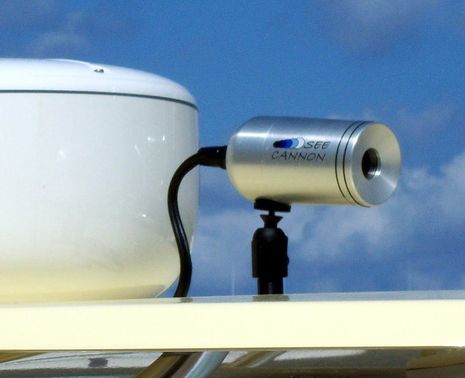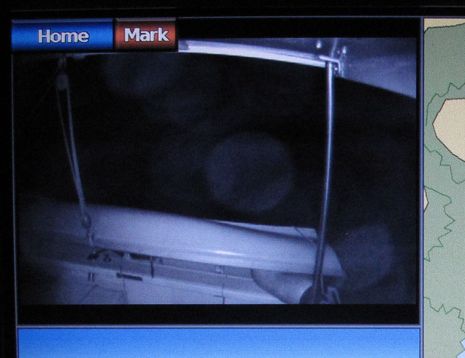NDCS See Cannon, ultra low lux boat cam
The name “See Cannon” doesn’t exactly roll off the tongue, but the concept is interesting. Encase a new generation ultra low lux camera in a small aluminum housing sealed to IP66 standards, offer a variety of 12v/video cable and marine mounting options, and market it as night vision for the many boaters who yearn for true thermal vision but can’t quite afford it. That seems to be the strategy of newcomer Night to Day Camera Systems, and I suspect its success turns largely on just what “ultra low” means…
The See Cannon is rated to 0.00003 lux or what NDCS calls a “starlight camera” and I don’t think I’ve ever seen such low lux in action. When I tested the dual payload FLIR M-626L last season I saw how its low light camera could see through heavy rain better than its thermal sensor, but the latter was much, much better in pitch dark. But I notice that FLIR rates that cam at 100 micro-lux, or 0.001 lux (corrected thanks to comments below, like the cross outs). And when you Google “ultra low lux camera” you’ll see all sorts of numbers, with very few claiming that extreme 0.00003 sensitivity. But does the $2,000 See Cannon see appreciably better than, say, a $240 Sony “lipstick” cam with “astounding 0.0003 lux low-light performance” (one decimal place)? Is low light technology really getting to thermal cam performance? I’m curious if any readers know more about what seems to be ultra ultra low light sensors? And maybe NDCS will let me take a Cannon out to a very dark area of the Bay where I took some photos of the FLIR in action? (Turns out the See Cannon is 0.0003 lux, not 0.00003, so much of the above is moot.)
Incidentally, this sort of low light technology is quite different from what’s sometimes bundled in boat cameras like the Raymarine Cam100 I started testing last fall. That cam offers beautiful color daylight views (which I’ll illustrate eventually), but when it auto switches to b&w night mode it’s only sensitive to 0.1 lux except for the nearby area illuminated by its IR LEDs. This is how it looks in “dark as a pocket” conditions…useful for keeping an eye on my Weaver bracketed rowing tender when running at night, but not much good beyond.















Ben, 100 microlux = 0.0001 lux.
The Sea Cannon’s 0.00003 lux = 30 microlux.
Pretty cool camera!
Without opening it you won’t know for sure, but my guess is you are looking at a Sony Lipstick in a $50 CNC turned housing with a custom cable and a typo on the 0.0000000000000000003 tera lux…
There is one other possiblity and that is BIN LOTS – many electronic components vary in performance from one piece to the next – given sufficient interest from the manufacturer, you can have parts sorted and essentially cherry pick the very best of the best – this usually adds about 10% to the cost of the component.
And after careful reading of the website it is 0.00030 lux. Playing with Lysdexia again. This is exactly the same as the Sony LS.
Pixel count is the same also – just reversed so you don’t pick up on it quickly…
Thanks Paul and Cattledog! I could have made an extra zero mistake like that, but actually it’s NDCS who goofed, one way or the other. In the FAQ it says, “The camera is rated at 0.00003 of a Lux” but in the specs it’s listed as “Minimum Scene Illumination: 0.00030 Lux”. I’ll ask for clarification because 0.00003 lux cams do exist:
http://www.securitymci.com/lowlightcameras.html
NDCS confirms that the specs, not the FAQ, is correct. The See Cannon is actually 0.0003 lux.
The company does have another camera that will go down .00005 lux, but says that once you get to four zeros “the camera becomes too sensitive and the picture does not look as crisp as 3 zeros.”
Speaking of FLIR, I just heard that their marine thermal cams are proving good at see oil in the Gulf. Video here:
http://www.youtube.com/user/FLIRNightVision
and more here:
http://www.flir.com/cvs/media/oilrecovery.
I tested one, and in low light it delivered a very nice image to the Simrad NX-45 I tested with. Much better than my eyes for sure. In no light, the display goes to snow. It is well made and I think it’s a pretty useful tool for coming into a harbour at night.
I also opened it up and the Low Lux camera inside is available just about anywhere for $275.00. Add in the cost of the CNC case, case lens, cables, assembly, marketing and profit and the price on the street is just about right.
Could you knock one off? Sure…Would that be worth it? Probably not…
Or buy 20 of them here and throw them away after each use…
http://www.easyspyshop.com/
Ultra Low Light B&W Bullet Camera .0003 Lux
$98.40
Camera and Mount only
This small Sony Ex-View Weatherproof 1/3″ CCD bullet camera practically sees in the dark with an astounding .0003 Lux low light sensitivity. 420 LOR assure a great picture even in very low light conditions. Standard 3.6mm lens with options of 6.8.10, and 12mm. Comes complete with removable sun shield and full swivel mount.
OR do what I did – add 8 Hella 700 Series driving lights to the electronics mast and turn night into day for the next 1000 yards.
8 55 watt halogen headlights…I bet the other night time boaters in your area are very appreciative! I still remember the time a tug who put his zillion candlepower spotlight on me one dark and stormy night when I was delivering a sailboat through Buzzard’s Bay. I appreciated his concern about what was probably a poor radar target, but I was completely night blind, and shook up, for quite a while.
Here’s an NDCS video comparison of See Cannon, daylight, and thermal cams. (But note that the thermal used is certainly not the higher res FLIR M636 type.)
http://www.youtube.com/watch?v=kJzDFTjBdQo
Have used the seacannnon a few times night fishing in eastern Long Island this Fall. Truely impresive for the price versus Thermal systems. Great depth of field which you don’t get with Thermal. But in total darkness you need a light source addition. I am adding one Hella HID light 3200 lumens to help. It should make it very good on a dark night. The resolution of the camera is so good you often end up driving the screen. For a reasonble expense anyone looking for nightvision will be very satisfied.
Thanks, Ray, love to hear how the combination of HID and low light camera work out. Meanwhile, others interested in low light cams, which do make a lot of sense for many situations, should check out the pan/tilt/zoom model that Boat-Cameras.com (in the U.K.) has introduced:
http://boat-cameras.com/Camera-16-IM-PTZ-16.php
Also sounds like Garmin, or at least Garmin in Europe, is working with Boat-Cameras:
https://panbo.com/archives/2010/11/garmin_new_echo_fishfinders_xhd_arrays_and_my-cast.html#comments